|
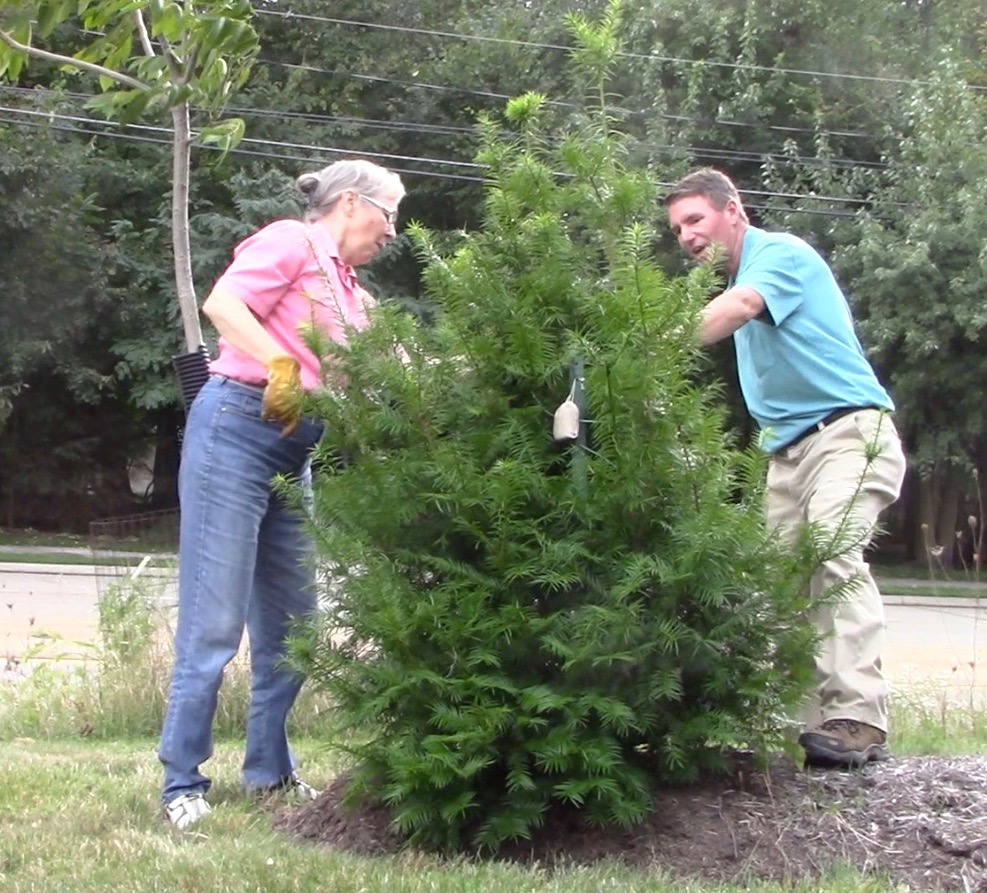 |
|
Case Study
Agency and Institutional Failures in
Endangered Species Management of
Florida Torreya
Report by Connie Barlow founder of Torreya Guardians
May 2021
Most recent update: January 2025
|
PHOTO ABOVE: Connie Barlow with Fred Bess in Cleveland, Ohio, October 2018.
They are examining the tallest of Fred's 4-specimen grove of Florida Torreya, which he planted in his front yard. Seed production began that year. The significance of SEED PRODUCTION in CLEVELAND OHIO is that this "experimental population" is 800 miles north of the plant's historical range.
List of Failures
1. FAILURE to include paleoecological scientific knowledge when discerning whether and for how long the risk of potential "invasiveness" in "recipient ecosystems" should stand as a barrier to beginning experimentation with poleward assisted migration of Florida torreya.
2. FAILURE to recognize and act upon the fact that species categorized as "glacial relicts" deserve expedited decision-making in this time of super-interglacial warming anthropogenically caused.
3. FAILURE to distinguish ultimate cause (Holocene warming) from proximate causes (various diseases) in posing and evaluating palliative actions and experiments for achieving species recovery.
4. FAILURE to visit and evaluate existing mature horticultural plantings in northward states, and from such assessments see for themselves that northward plantings are not impaired by disease and thus continue to evidence health, reproduction, and (in some cases) full naturalization in northward states.
5. FAILURE to visit wild Torreya californica to learn genus habitat preferences and abilities — not just minimal tolerances in relictual Florida range.
6. FAILURE to numerically document the tens of thousands of seeds produced annually in the ex situ groves, especially in northern Georgia (southernmost Appalachian foothills and mountains) and to record their ultimate destinations.
7. FAILURE to document just about everything that the agency and institutions have learned over 35 years of operating under a recovery plan.
8. FAILURE to ensure that all ex situ seeds would be put to use in advancing scientific understanding, including experimenting with poleward ability to thrive.
9. FAILURE of the U.S. government and NGOs to offer mediation and work toward solutions when the relationship between volunteers in Torreya Guardians and the two official botanical gardens had deteriorated to such a point that collaboration (which had been written into the 2010 recovery plan update, p. 18, as an activity to seek) had turned into its opposite.
10. FAILURE (even after 35 years of management) to reach actionable conclusions as to whether the risks posed in the abstract for any plant translocation beyond historically native range actually merited concern when applied to the case of Florida Torreya.
11. FAILURE to value the importance of qualitative, multi-factor experienced judgment that cannot emerge from solely quantifiable, publishable data. In other words, this is a failure to carry forward the experiential practice of our natural history elders in what is now called western science, and who made significant discoveries prior to the favoring of quantitative forms of data gathering and documentation.
12. FAILURE to value and declare "rewilding" as the ultimate goal of recovery action, rather than settling for mere "prevention of extinction" or, worse, minimalist "safeguarding of genetic material."
13. FAILURE to include in the agency's DECISION on Barlow's September 2019 "PETITION TO DOWNLIST Florida Torreya" (from "endangered" to "threatened"; 26 pages PDF) any climate adaptive policy for enabling species "recovery" to track geographic climate range shifts — rather than being restricted to "historical range."
14. FAILURE to practice "adaptive management" in accordance with the paradigm shift in botany toward a "plant microbiome" and "seed microbiome" framework. A correction would require that the identified causal agent of stem canker within Torreya's native range, Fusarium torreyae, be re-evaluated in accordance with the full spectrum of symbiotic relationships (mutualistic and commensal as well as pathogenic) that professionals have recently catalogued among the many fungal and bacterial "endophytes" in intimate association within all tissues of all plants.
 |
|
• AN OPPORTUNITY EMERGES IN 2025
Owing to the change in the executive branch, there is an opportunity to utilize the DOGE initiative (to reduce federal costs and increase efficiency) such that agency staff can have their time freed up to engage in real and practical actions toward fulfilling the goals of the statute.
Currently, staff are overburdened with bureaucratic and litigation demands that have ramified over the course of 51 years since the Endangered Species Act became law — and that wise POLICY shifts can ameliorate, without the need to change the law or its regulations.
|
ABOVE: 70-minute video by Connie Barlow , founder of Torreya Guardians (posted November 2024).
RECOMMENDED READING is the "Challenges and Controversies" section of the Wikipedia page "Endangered Species Act of 1973". July of 2023, Connie began to edit this wikipedia page to improve it before the 50th anniversary of the statute in December 1973. Her work continued off and on through early January 2025. The "Challenges and Controversies" content is a substantial new section that she contributed and wrote in its entirety. This wikipedia section is recommended because it reveals in great detail how the bureaucratic and litigation demands on agency staff have amplified exponentially over the years.
Case Study Supplement: "Petition to DOWNLIST from endangered to threatened Torreya taxifolia"
• Petition to Downlist (26 pages)
• History of Petition to Downlist (the filing and correspondence)
Note: September 2019, Connie Barlow (as an individual) submitted a petition to downlist Florida Torreya. The petition is a crucial supplement to this case study because it focuses on Torreya Guardians accomplishments, rather than agency and institutional failures. However, because the agency's PETITION DECISION in September 2021 failed to respond to the need for climate adaptation, Point #13 includes details on the agency's demonstrated tardiness in accepting climate change as real and thus as necessary to accommodate in endangered species recovery plans.
Introduction to the Case Study
The following list was compiled by Connie Barlow in May 2021, based on her experience as founder and chief advocate for Torreya Guardians beginning in 2004. As always, she writes as an individual because
Torreya Guardians does not speak or take action as a group, but instead encourages subsets of those involved to post ideas and initiatives on this website and to help establish links with synergistic organizations and websites. There are no by-laws, officers, board, staff, overhead costs, dues, formal organizational structure, or physical location to this organization.
Barlow's critique herein of endangered species program management as it pertains to Florida Torreya is intended to offer her personal experience of what she regards as "failures" in official agency and institutional actions, documentation, and stakeholder/public relations pursuant to the USA Endangered Species Act designation of Florida Torreya as an endangered species in 1984. Her aim is to help professionals develop their own sense of what went wrong — and what could henceforth go right — by way of careful study of this first and well documented case of conflict over whether, how, and who to commence "assisted migration" of a recognized endangered plant species.
Note: A 1988 paper published in Pace Environmental Law Review offers an excellent history of the long-held distinction in U.S. governmental regulation of plants v. animals ("wildlife") and how that distinction was forged into a compromise that entailed less rigid regulation (and to some extent, entire "exceptions") for how plants would be handled under the 1973 Endangered Species Act. See in pdf the 1988 article by Faith Campbell, "Legal Protection of Plants in the United States", which is also a reference for the PLANTS paragraph in the ESA 1973 wikipedia entry.
Barlow was motivated to assemble this page following publication of an April 2021 "Policy Forum" advocacy piece that appeared in the journal Science:
• "Global Policy for Assisted Colonization of Species" , by Jedediah F. Brodie, Susan Lieberman, Axel Moehrenschlager, Kent H. Redford, Jon Paul Rodríguez, Mark Schwartz, Philip J. Seddon, James E. M. Watson.
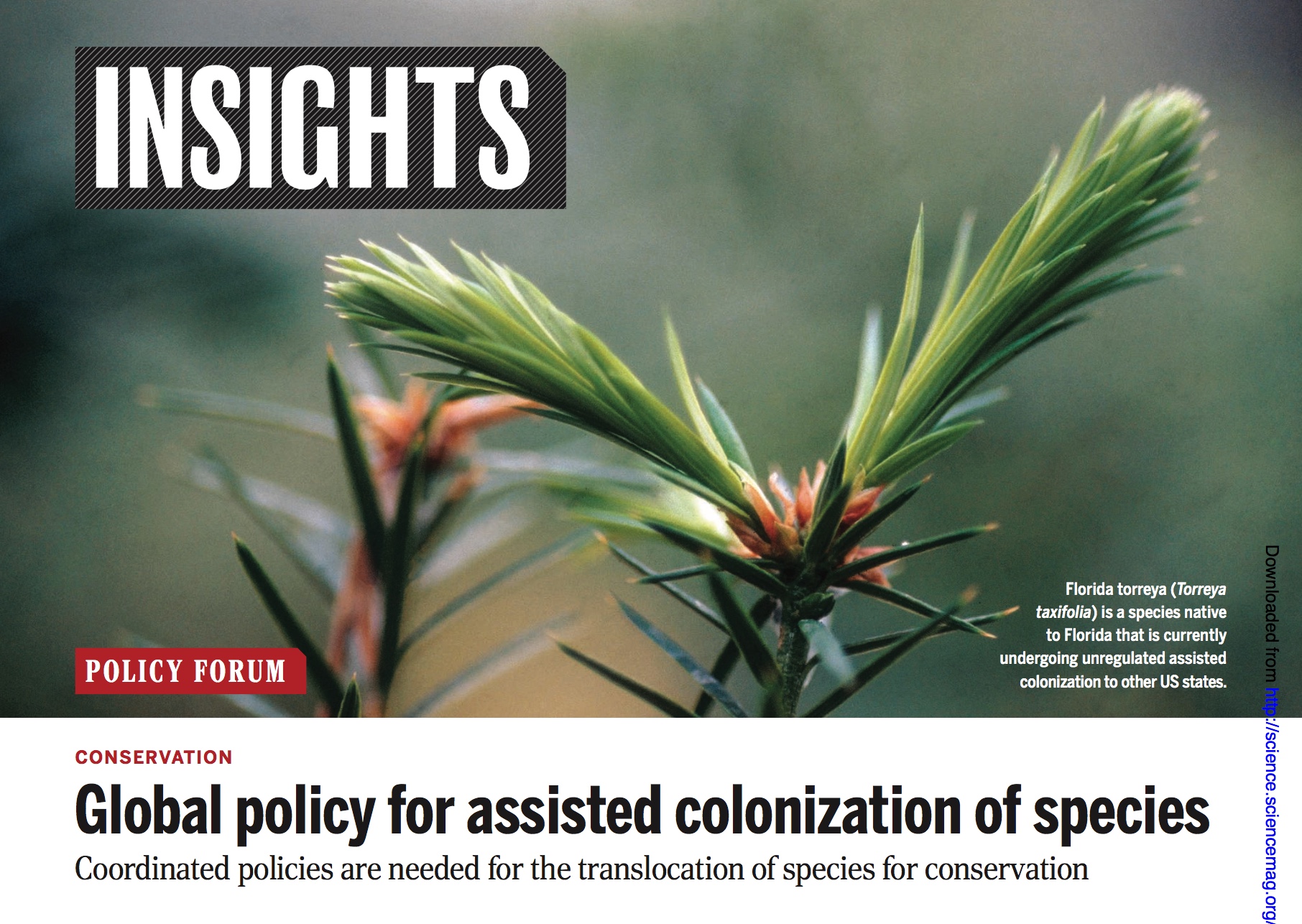
|
|
Via that paper, Barlow became aware that global decisions on "climate adaptation" practices will be worked into the existing U.N. Convention on Biological Diversity, scheduled for update at a conference in China October 2021.
She hopes that in communicating wrong turns by agency and institutional implementers of the U.S. Endangered Species Act, other imperiled plant species may have smoother rides toward habitable futures.
See also a news article on the Brodie et al. paper and its context: "Amid Climate Pressures, a Call for a Plan to Move Endangered Species", by Zach St. George, in Yale Environment 360, 19 May 2021.
|
For readers unfamiliar with "assisted migration/colonization" as a climate adaptation tool, you may wish to begin by accessing the "Assisted Migration Scholarly Links" webpage, which Barlow created in 2007 and has been updating ever since. Her aim has been to report, link, and excerpt all the key papers (and some media reports) — whether pro or con, and without bias. Many of these papers presented Florida Torreya as the leading test case. For example, of the 15 citations listed for the above, "Global Policy ..." paper in Science, these four mention Florida Torreya and/or Torreya Guardians: Butt et al. 2020; Schwartz and Martin 2013; Ricciardi and Simberloff 2009; Schwartz et al. 2012.
Global participants in endangered plant recovery are encouraged to become acquainted with the ongoing debate in terminology — especially the importance of "decolonizing" scientific language.
Inspirational Quotation: "Let us not abandon species because their natural setting is being lost. We should acknowledge that 'natural settings' rarely exist anymore anyway; climate change means all settings are impacted by human activity. Do not be so quick to abandon species because their ecological context is changing. If possible, find them a new one."
— Brian Buma, 2013, "Don't Give up Just Yet: Maintaining Species, Services, and Systems in a Changing World", Ethics, Policy, and Environment 16:1, 33-36
Case Study
Agency and Institutional Failures of
Florida Torreya
Endangered Species Implementation re "Assisted Migration"
by Connie Barlow, founder of Torreya Guardians
May 2021 • most recent updiate is January 2025
1. FAILURE to include paleoecological scientific knowledge when discerning whether and for how long the risk of potential "invasiveness" in "recipient ecosystems" should stand as a barrier to beginning experimentation with poleward assisted migration of Florida torreya. Distinct failures include:
1A. Failure to engage a broad understanding that shifts in geographic ranges during the past 2.5 million years of glacial/interglacial cycling repeatedly subjected plant species of the eastern USA to different community types and species interactions — by which one would arrive at greatly reduced fears that same-continent poleward assistance in migration of any native plant species could result in ecological harm to species in the "recipient ecosystems." (See the 2011 APPENDIX A, at bottom, where Barlow presented this point in depth.)
1B. Failure to acknowledge that absence of Cenozoic fossil evidence is not evidence of Torreya's absence poleward of its Cretaceous fossil locale. Unlike the volcanic-rich western USA, the Cenozoic calm of the eastern USA means that very few upland plant species are represented as macrofossils. And while the eastern USA has a rich Pleistocene-Holocene record of pollen of many tree species preserved in bogs, palynologists cannot distinguish morphological differences in pollen of these four genera: Torreya, Taxus, Taxodium, and Cupressus.
2. FAILURE to recognize and act upon the fact that species categorized as "glacial relicts" deserve expedited decision-making in this time of super-interglacial warming anthropogenically caused.
SOURCE: Natural History of Florida Torreya webpage on Torreya Guardians website.
2A. Failure to recognize that, by definition, glacial relicts were unable to adjust their ranges in sync with interglacial warming. Even before industrialization of the human presence on Earth initiated rapid additional warming, glacial relicts had been "left behind" in habitats and in numbers far reduced in size from what is necessary for long-term survival, especially as climate warming continues.
2B. Failure to carry forward the significance of Florida torreya as a glacial relict, which was a prime descriptor of this species in its 1984 ESA designation as an officially endangered species and in its first recovery plan (1986) and even in its 2010 recovery plan update. Only one sentence in the 2020 updated plan speaks to this range mismatch, p. 16:
"Based on fossil records, we can speculate that the geographical range of T. taxifolia included North Carolina and perhaps, it was forced south by glaciers, and when they retreated, it became isolated in small areas of the southeastern United States."
Unfortunately, the two major implementing institutions of the recovery plan (Atlanta Botanical Garden and State Botanical Garden of Georgia) do not make note of the glacial relict status of Florida Torreya in their current taxon descriptions online and in public writings and statements.
2C. Failure to take note of microsite evidence that Florida torreya cannot be restored to health in its historically native range. Clearly the species has already retreated to the coolest microsites. This, on the wikipedia page of Torreya taxifolia:
"It grows at altitudes of 15 to 30 meters (49 to 98 ft), mostly on wooded ravines, bluffs and steep,[1][9][8] north-facing slopes.[1] These ravines have nearly permanent seeps. It also occurs in the bottoms of ravines and adjacent floodplains.[8] It grows in the shade under the canopy of larger trees.[1][7][8]"
3. FAILURE to distinguish ultimate cause (Holocene warming) from proximate causes (various diseases) in posing and evaluating palliative actions and experiments for achieving species recovery. Barlow presents this argument in depth in this subsection of the webpage "Endangerment: causes of" on the Torreya Guardians website, which she updated in detail in 2018, following media reports that a University of Florida forestry pathologist recommended genetic engineering for disease resistance — prior to any official attempt to evaluate historic and recent horticultural successes in planting Florida Torreya northward.
4. FAILURE to visit and evaluate existing mature horticultural plantings in northward states, and from such assessments see for themselves that northward plantings are not impaired by disease and thus continue to evidence health, reproduction, and (in some cases) full naturalization in northward states. In contrast, Torreya Guardians have accomplished this work and posted text and illustrations on our Historic Groves webpage.
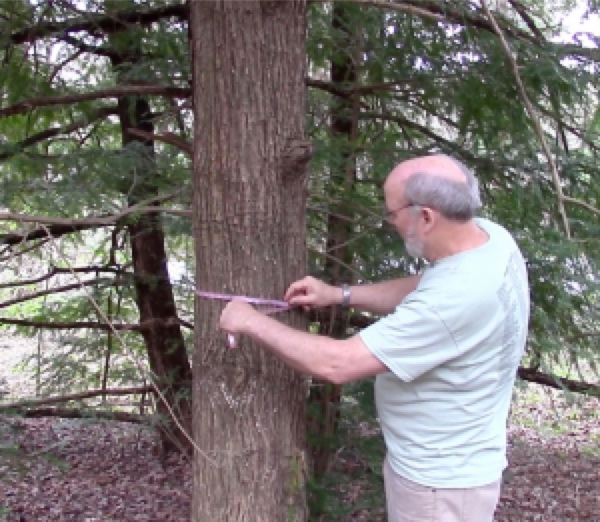
|
|
4A. Torreya Guardians volunteers have documented thrival, reproduction, and even naturalization of next-generation seedlings and saplings at near-century-old horticultural plantings of Florida Torreya at the Biltmore Gardens and Harbison House in the mountains of North Carolina.
LEFT: Jack Johnston measures girth of the largest torreya at Harbison House, south of Highlands, North Carolina. This site documents that in the course of a century, the species has been able to disperse seed and thus establish an expanding population only a distance of 40 yards — far less than what will be required of all species in even the next decade.
|
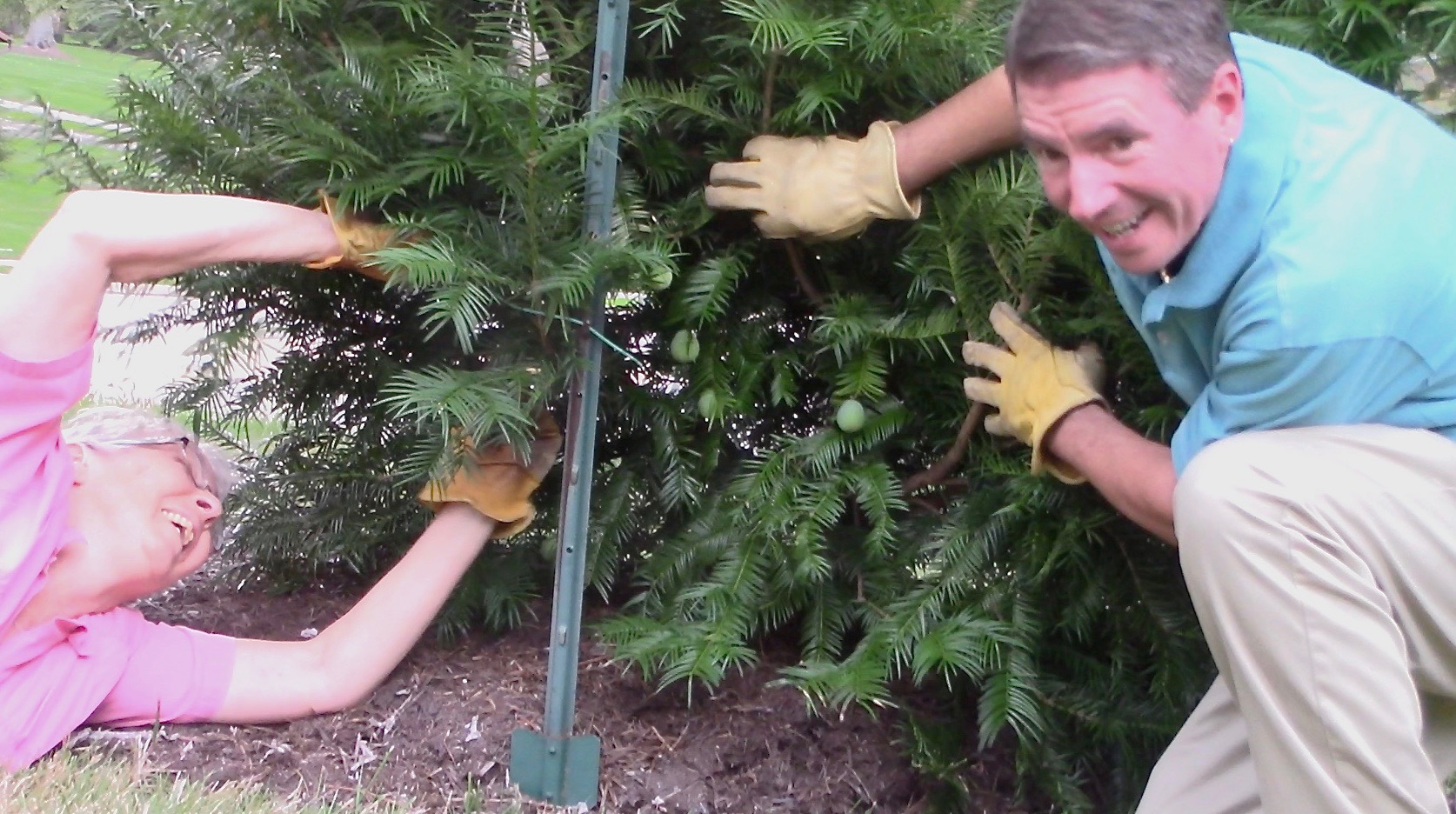
|
|
4B. Our own Torreya Guardians plantings have documented not only survival but seed production as far north as Cleveland, Ohio.
LEFT: In October 2018, Connie Barlow and Fred Bess were thrilled to count 19 seeds on one of the torreya trees Fred had planted in his yard in Parma, OHIO (a suburb of Cleveland) a decade earlier. (Seed production by 2023 had increased to over 1,000 annually.)
Some of those seeds are now seedlings, outplanted into the regrowth forest of another Torreya Guardian in a mountainous section of Virginia.
|
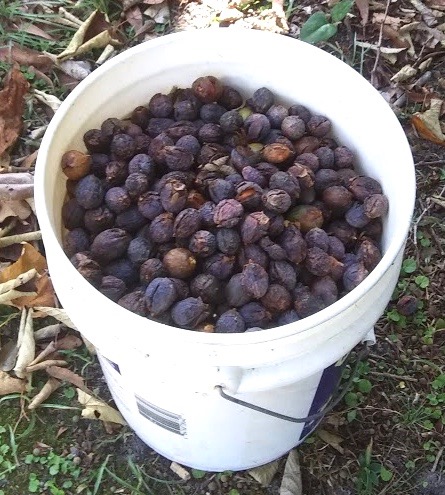
|
|
4C. Failure to value seeds produced in horticultural settings as (a) potentially suitable for boosting genetic diversity and (b) offering opportunities for experimental plantings that could yield important learnings, while risking substantial losses in the process. (One learns the full scope of habitat preferences not only by successes but equally by failures.)
LEFT: 1,383 ripe seeds were collected on 31 October 2020 by Torreya Guardians at two horticultural plantings in south-central North Carolina. Within 3 weeks, most of the seeds were distributed to existing planters and new volunteers — especially to those who had the right forest types for "free-planting" seeds directly into forest soils. (Torreya seeds are recalcitrant; they cannot be stored.)
|
• Access more than a HALF-DOZEN RESEARCH PAPERS on the importance of HISTORIC GROVES planted outside of native ranges to aid botanical decision-making in this time of rapid climate change.
5. FAILURE to visit wild Torreya californica to learn genus habitat preferences and abilities — not just minimal tolerances in relictual Florida range. Such preferences include elevation, slope, aspect, canopy lighting, associated plants, stem regeneration, conditions for seed production in the wild, seed dispersal distances, ability for root crown to resprout new stems after fire.
Note: Mark W. Schwartz and Sharon M. Hermann did visit field locales of wild California Torreya in 1998. But their research objective was to measure a statistically significant number of T. californica specimens for imputing annual upward growth of leader stems. This was accomplished in order to determine "Is Slow Growth of the Endangered Torreya taxifolia (Arn.) Normal?". This paper was published in the Oct-Dec 1999 issue of Journal of the Torrey Botanical Society. Because there was no conclusive determination at that early time whether some disease or failing environmental conditions in the Florida native range were the ultimate cause of loss of mature stems and reproduction, the authors did not document environmental information that could be helpful for learning the sister species' preferences and tolerances in habitat types. And no papers or online documentation were later offered that could assist in habitat comparisons until Barlow's photo and text postings of her 2005 California field visits.
6. FAILURE to numerically document the tens of thousands of seeds produced annually in the ex situ groves, especially in northern Georgia (southernmost Appalachian foothills and mountains) and to record their ultimate destinations.
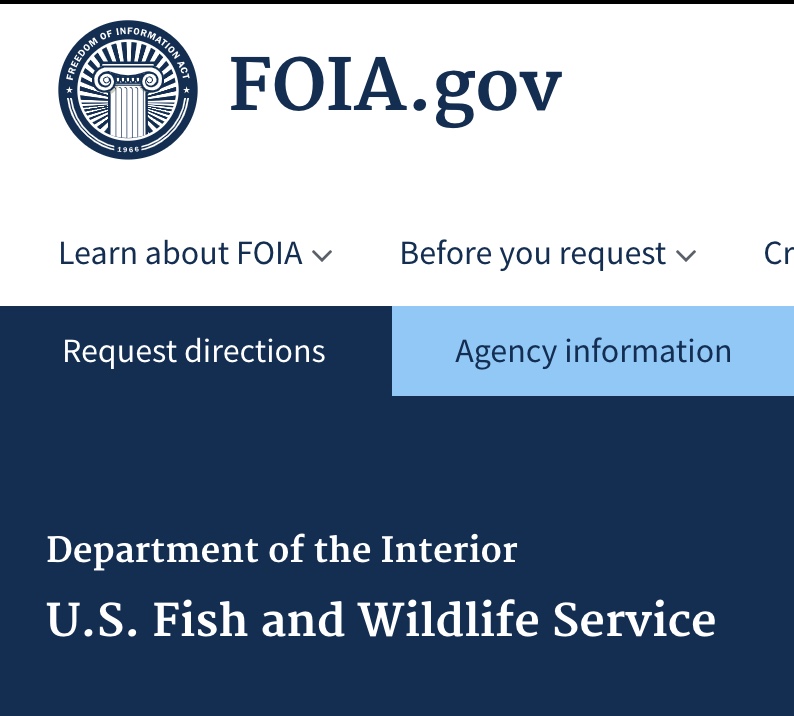
|
|
Because north Georgia is significantly poleward of northern Florida, the ex situ groves offer valuable scientific evidence of ability to thrive and reproduce poleward. Both the Atlanta Botanical Garden and the State Botanical Garden of Georgia have failed to document seed production and ultimate destinations of those seeds.
This failure was confirmed via the results of a Freedom of Information Act query placed by Barlow in 2018. All results and correspondence are accessible on the FOIA webpage of the Torreya Guardians website.
Because Torreya seeds are recalcitrant; they cannot be stored dry or in cryo. The results of the FOIA confirm that genetically significant seeds likely numbering in the tens of thousands have thus been wasted over the past dozen years, since seeding began in north Georgia.
|
UPDATE JUNE 2021: Barlow encountered this month a posted VIDEO of a presentation made by Dr. Emily Coffey of Atlanta Botanical Garden in May 2018. Her 10-minute presentation at the national meeting of the Center for Plant Conservation is an excellent review of Florida Torreya's deteriorating presence in its small native range. Her presentation also presents ongoing actions by Atlanta Botanical Garden — including reporting that in one of the ex situ plantings in northern Georgia (Blairsville), some 13,000 seeds were produced fall 2017. Of those, she reports that some 4,000 were distributed to various institutions. She does not specify the ultimate destinations of the remaining 9,000 seeds. Note: Because Dr. Coffey's documentation of 13,000 seeds produced in 2017 is so important, Barlow collected a half-dozen screenshots from the video and posted these with excerpts of the audio presentation onto a new webpage on the Torreya Guardians website. Here is the link to images and excerpts of Dr. Coffey's 2018 presentation.
7. FAILURE to document just about everything that the agency and institutions have learned over 35 years of operating under a recovery plan. The agency and participating institutions have also failed to offer those accomplishments and learnings in a form (online) that is readily accessible, searchable, and updatable — such that other professionals and the public could learn and make their own evaluations toward enhancing recovery of this species. In contrast, Torreya Guardians documents and posts online its actions, learnings, successes, and failures.
8. FAILURE to ensure that all ex situ seeds would be put to use in advancing scientific understanding, including experimenting with poleward ability to thrive. Because the large seeds of genus Torreya are recalcitrant, they cannot be stored by drying or by freezing in cryo. Nevertheless, as demonstrated by Torreya Guardians, even thousands of seeds annually can be put to use experimentally simply by way of direct planting of seeds into forested landscapes. Refer to the Freeplanting Seeds and Propagation Best Practices pages on the Torreya Guardians website for documentation of what this group has learned about planting placement and depth for achieving the best results.
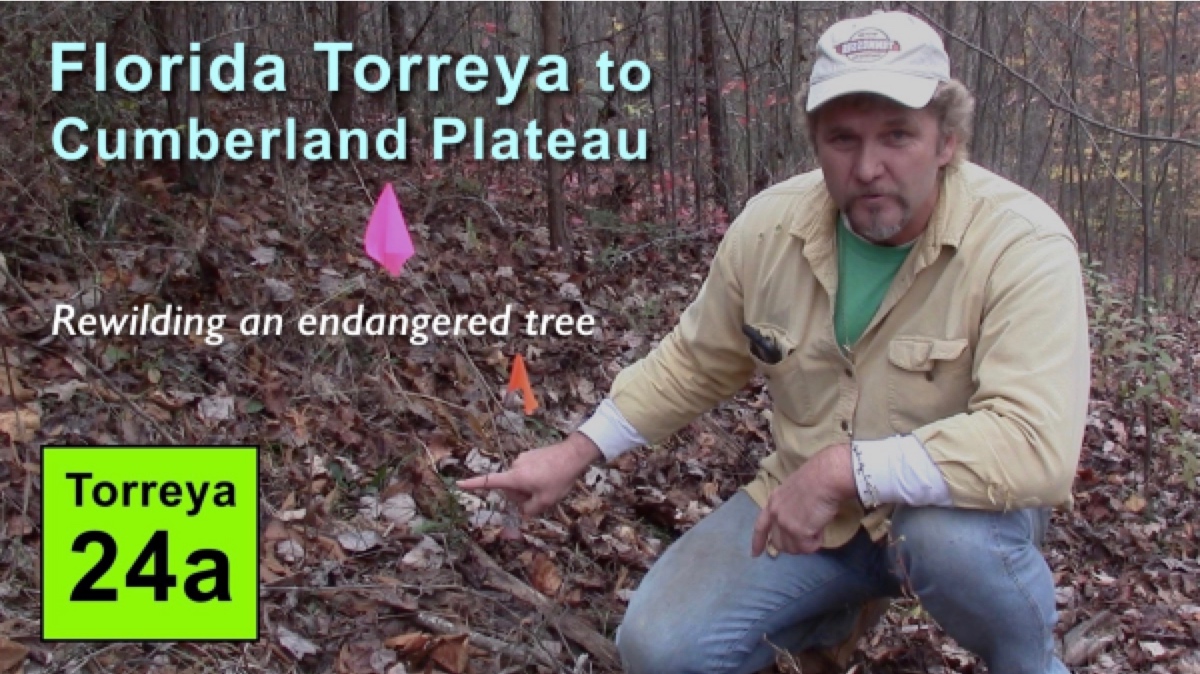
|
|
8A. Because Torreya Guardians had already nurtured northward private planters of potted seedlings legally obtained from nurseries, it was possible for us to ramp up plantings during the years we had access to thousands of seeds annually — most recently, annual seed harvests in North Carolina from 2019-2022.
We simply advised recipients to put seeds 4 inches deep directly into forest soil. Our first such large-scale planter owns a 232-acre forest west of Spring City, Tennessee. The Anderson family was able to plant (and mark by flags) 400 seeds over the course of two days, November 2015. |
9. FAILURE of the U.S. government and NGOs to offer mediation and work toward solutions when the relationship between volunteers in Torreya Guardians and the two official botanical gardens had deteriorated to such a point that collaboration (which had been written into the 2010 recovery plan update, p. 18, as an activity to seek) had turned into its opposite.
This break was set into policy when the U.S. Fish & Wildlife Service signed a document May 2016 with other institutions in Georgia urging a halt to communications with Torreya Guardians — but neglecting to advise our organization of this step and thus never giving us a chance to refute the accusations against us. Excerpt of this statement:
"...GPCA members and Botanical Guardian volunteers are advised to be cautious when speaking to any members of Torreya Guardians. They have taken advantage of professional courtesies, making broad claims from simple correspondence, and linking their work with members of the GPCA. GPCA is publicly distancing itself from Torreya Guardians and their methods of rewilding an endangered species outside its range...."
The 6 signatories entailed one staff person from the U.S. Fish & Wildlife Service, one from Georgia DNR, one from the Atlanta Botanical Garden, two from the State Botanical Garden of Georgia, and one from the Chattahoochee Nature Center. Torreya Guardians (Connie Barlow) did not learn of this statement and its consequent shut-down of communications until February 2018, by way of a non-signatory, newly hired staff person at the Atlanta Botanical Garden.
When Barlow finally received a copy of this document two years after it was set as policy, she sought redress. Failing that, in retaliation she launched the FOIA process (see Failure 6, above) to make public the scientific lapses in seed documentation and distribution by the official institutions that she was well aware of. In her view, these lapses by the managers of the two most seed-productive ex situ groves (clones of the native genotypes) at Smithgall Woods and Blairsville GA were far greater impediments to torreya's recovery than any accusations or complaints that had been made against the actions of Torreya Guardians.
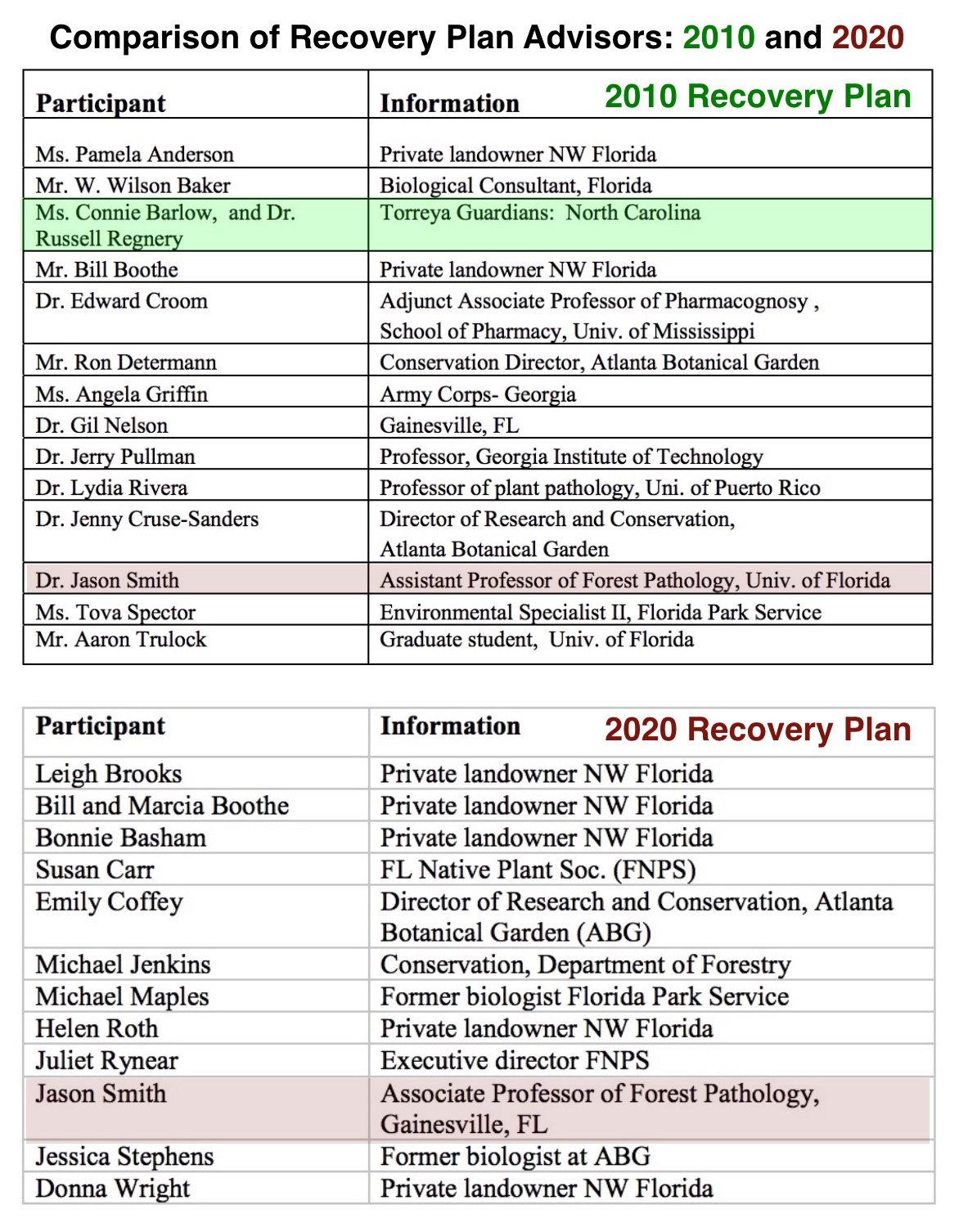 |
|
Two years later, the federal agency in charge of recovery also failed to notify Torreya Guardians of a draft recovery plan update offered for public comment in 2020.
In contrast, we were invited by that same agency to participate in an advisory conference call during the 2010 update process.
SEE IMAGE LEFT, where Torreya Guardians are in green. The only advisor acknowledged in both the 2010 and 2020 plan updates is Jason Smith, forest pathologist at the University of Florida.
As well, the 2020 plan not only failed to include as accomplishments any of our documented plantings and seed production, but slandered we citizens by describing us as "a religious group based out of northern Georgia" (p. 6).
Note: For anyone unaware of how Torreya Guardians is viewed in the wider scope of conservation, visit the "media" section of our History of Torreya Guardians webpage. |
STATE OF GEORGIA opposition to assisted migration: Georgia Department of Natural Resources: Biodiversity Portal page on Torreya taxifolia (last updated 2020 by Linda G. Chafin, a conservation biologist who retired from the State Botanical Garden of Georgia that same year). When Connie Barlow accessed this page in 2025, "assisted migration" was presented as a "threat" to this species: "Logging, conversion of habitat to pine plantations, fungal blight, extreme hurricane events, diversion of resources to uninformed and unauthorized assisted migration efforts." In the section titled "Conservation Management Recommendations" this appears: "Discourage attempts at assisted migration unless carried out by authorized agencies."
10. FAILURE (even after 35 years of management) to reach actionable conclusions as to whether the risks posed in the abstract for any plant translocation beyond historically native range actually merited concern when applied to the case of Florida Torreya. The two risks identified in the early and continuing scientific papers and appraisals are: (1) risk of inability to thrive in a poleward locale (hence wastage of public or NGO funds), and (2) risk that poleward migration might be too successful in the "recipient ecosytem", thus invasively upsetting the health of the ecological community and/or the survival of any of the resident species. In contrast, the homepage of Torreya Guardians makes easily accessible documentation for professionals and the public to gain confidence for themselves that the risks are minimal to non-existent. The lengthy documentation includes links to the Historic Groves webpage, our Learnings webpage, and to state-by-state webpages pertaining to each site of Torreya Guardians volunteer plantings.
11. FAILURE to value the importance of qualitative, multi-factor experienced judgment that cannot emerge from solely quantifiable, publishable data. In other words, this is a failure to carry forward the experiential practice of our natural history elders in what is now called western science, and who made significant discoveries prior to the favoring of quantitative forms of data gathering and documentation. In contrast, the value of Torreya Guardians "citizen science" is almost entirely of a natural history, qualitative type. Barlow stresses this point in the context of her November 2021 video, "Helping Subcanopy Trees Migrate", 50 minutes ("natural history" analytical advocacy for both subcanopy pawpaw and torreya begin at timecode 18:00).
12. FAILURE to value and declare "rewilding" as the ultimate goal of recovery action, rather than settling for mere "prevention of extinction" or, worse, minimalist "safeguarding of genetic material." As I stated in my 24 July 2018 communication to the agency staff working through my FOIA inquiry:
... But the Endangered Species Act, which was enacted while I was still in college, was not limited to merely preventing extinction or "safeguarding" the genetics of the species. As a young adult, I was thrilled to witness the gains of how the act was implemented in its early years. The ESA not only prevented extinction of the Peregrine Falcon and the Bald Eagle but helped them to regain their prominence and geographic range in the wild...."
Note: Connie Barlow was an early advocate and shaper of the understanding of conservation "rewilding" of species, via a 1999 essay she contributed to Wild Earth magazine: "Rewilding for Evolution". In 2021, she added a section to the wikipedia page "Rewilding (conservation biology)". The section she added is titled "Rewilding Plants".
13. FAILURE to include in the agency's DECISION on Barlow's September 2019 "PETITION TO DOWNLIST Florida Torreya" (from "endangered" to "threatened"; 26 pages PDF) any climate adaptive policy for enabling species "recovery" to track geographic climate range shifts — rather than being restricted to "historical range."
• APPENDIX B entails a summary of Barlow's 26-page petition.
Here is how Barlow summarized the 29 September 2021 decision (with links) on the Reports page of the TG website.
CONNIE BARLOW WRITES: Because Torreya Guardians is an informal organization and does not make decisions nor speak with a single voice, in Sept 2019 I filed, as a lone individual, a PETITION TO DOWNLIST THE FLORIDA TORREYA. (Scroll down to Sept 2019 on this chronological reports page to see my own statement and link to the petition.) On Sept 29, 2021, the USF&WS posted its decision, ruling against my proposed downlisting to "threatened" status.
My original intention was not to achieve actual downlisting, but to compel the agency to publish a decision that recognized our substantial achievements in documenting northward thrival in historic plantings and our own learnings as to best propagation techniques and choice of planting sites.
Ultimately, I hoped that such recognition would lead to official embrace of "assisted migration experimentation" — and thence to agency and public pressure aimed at calling out the climate-denying standards established by the two botanical gardens controlling ex situ seed dissemination.
My continuing hope and advocacy is for the Atlanta Botanical Garden and the State Botanical Garden of Georgia to be compelled to cease requiring botanical gardens north of Georgia to assent to Memorandums of Understanding pledging to utilize the seeds exclusively for genetic safeguarding. Until that limitation is removed, those of us engaged in poleward planting and experimentation will be barred from accessing the full genetic diversity of Torreya seeds — thus resulting in assisted migration projects unnecessarily burdened by limited (and possibly dangerously inbred) genetics from seeds produced from limited horticultural parents.
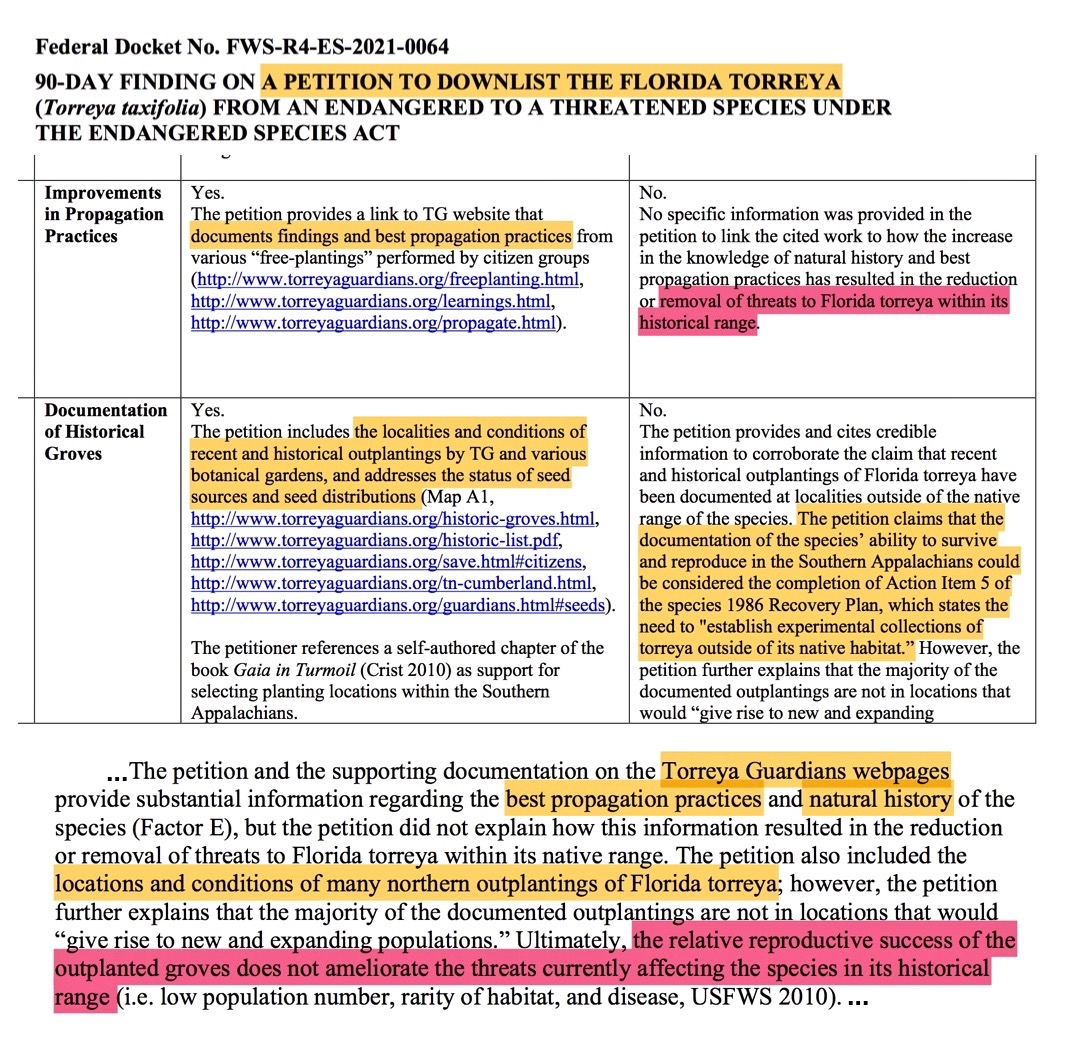
ABOVE: Excerpts from the 11-page decision . YELLOW highlights passages where USF&WS acknowledges the value of Torreya Guardians' contributions in discerning "best propagation practices," "natural history" learnings, and documentation of "localities and conditions of recent and historical outplantings ... seed sources and seed distributions." PINK highlights crucial passages where the agency reveals an absence of any climate adaptation policy.
MORE EXCERPTS OF BARLOW'S RESPONSE TO THE AGENCY, 30 September 2021:
... My aim was not so much to achieve a downlisting, but to get some attention that the policy of "historic range" needs to have a "climate adaptation" update, as pioneered by the National Park Service in April via its new "RAD" policy [Resist-Accept-Direct]. USDA has long been moving in the climate adaptive direction, without a great deal of fanfare. USFS research staff have published tree species range shift projections. As well, the agency is working to make the science of range shift accessible to forest owners and managers in the USA — including some very substantial work with tribal forestry staff. That work is carried out by staff at the Northern Institute of Applied Climate Science.
... Bottom line: I believe the USF&WS branch of DOI can produce a policy statement that would authorize, on a case-by-case basis, "endangered species" decisions to begin including climate adaptive responses in favor of suitable conditions in "projected ranges" — not just limited to trying to manipulate the habitat of "historic ranges" to enable species thrival again. This is especially vital for any plant species classified as a "glacial relict" to ever achieve suitable habitat in this rapidly changing climate. New habitat poleward is the only chance to ever delist the plant. Otherwise "safeguarding genetic materials" will be perpetual and never enable a full wild presence.
14. FAILURE to practice "adaptive management" in accordance with the paradigm shift in botany toward a "plant microbiome" and "seed microbiome" framework. A correction would require that the identified causal agent of stem canker within Torreya's native range, Fusarium torreyae, be re-evaluated in accordance with the full spectrum of symbiotic relationships (mutualistic and commensal as well as pathogenic) that professionals have recently catalogued among the many fungal and bacterial "endophytes" in intimate association within all tissues of all plants. (June 2025 Barlow posted a 54-page PDF: Applying the Plant and Seed Microbiome Paradigms to the endangered Florida Torreya tree.)
Updates (chronological) of Torreya Guardians Actions and Recommendations to the USF&WS
• UPDATE 19 MAY 2022: Connie Barlow submitted a 2-page "Request" for the (newly appointed) director of the U.S. Fish & Wildlife Service to review the citizen accomplishments of Torreya Guardians. Barlow concluded this way:
"REQUEST: Please have a high-level, policy staff person visit the Torreya Guardians website: http://www.torreyaguardians.org/ From the home page, click on the link titled, "Case Study of Agency Failure." As well, our "Historic Groves" link is intended to be a strong and visually rich survey of how well the climate in the Appalachians and northward supports this glacial relict's health: notably its ability to fight a range of native diseases that have made the species functionally extinct in its historically native range. As well, do take a look at our documentation of what we have learned, especially to educate and guide volunteer planters via our "Propagation" page. Finally, please consult with USDA climate lead, Chris Swanston, who is well situated to educate conservation scientists in FWS about the forestry research scholarship that has welcomed "assisted migration" as a climate adaptation tool for timber management and forest ecosystem services. A well-regarded summary of the forestry science on this topic is a wikipedia page I coauthored in 2021 with a Canadian: "Assisted migration of forests in North America." I look forward to the possibility of Florida torreya becoming a highlighted achievement of FWS for the 50th anniversary of the ESA, instead of a sad example of ongoing climate denial and hostility toward citizen contributions."
• UPDATE 8 AUGUST 2022: Connie Barlow submitted a comment on the proposed federal regulation to eliminate "historical range" as the sole locus for endangered species recovery. After voicing a YES to the proposal, she posted a 5-page PDF that offered RECOMMENDATIONS FOR IMPLEMENTATION:
1. Create implementation frameworks and policies that are distinct for plants.
2. Encourage nongovernmental entities to use the ESA "exception" for plants.
3. Follow the lead of the USDA Forest Service [in their own "assisted migration" terminology and actions].
4. Facilitate respectful dialogue and understandings of worldview differences.
• Barlow Comment, 5-page PDF here or here
• Barlow summary of key institutional comments among the 553 posted (10 pages PDF)
• UPDATE 15 NOVEMBER 2022: Connie Barlow posted on youtube a richly illustrated HISTORY OF TORREYA GUARDIANS: VIDEO EPISODE 35: Torreya Guardians - Reflections by Connie Barlow
 |
|
While cleaning and sorting torreya seeds freshly harvested from a private home in Clinton, NC, Connie extemporaneously delivers the history of significant beginnings, achievements, and frustrating institutional obstacles that she and other volunteers encountered during nearly two decades of action and advocacy in behalf of this endangered subcanopy tree.
The final 5 minutes is where she explains the new governmental proposal to authorize "assisted migration" for climate threatened species, such as this glacial relict.
|
VIDEO: 43 minutes, with timecoded table of topics in the youtube caption. Access the full list of TG videos.
• UPDATE: SUMMER OF 2023 NEW OPPORTUNITY FOR ASSISTED MIGRATION. A combination of two events has, at least in the abstract, reopened the possibility for the official recovery program to begin northward "experimental populations" of Florida Torreya:
1. The EXPERIMENTAL POPULATIONS regulation of the 1973 Endangered Species Act was amended on 30 June 2023 to expressly authorize "experimental populations" to be sited in locations beyond the previously mandated "historical range". The official press release justified the change in order "to reduce the impacts of climate change and other threats such as invasive species".
2. The FUSARIUM TORREYAE FUNGUS IN TORREYA SEEDS MAY BE A MUTUALIST. Connie Barlow reports in August 2023: "Until this month I was unaware that in 2015 agricultural research pathologists initiated a PARADIGM SHIFT in how they regard fungal endophytes (including Fusarium species)."
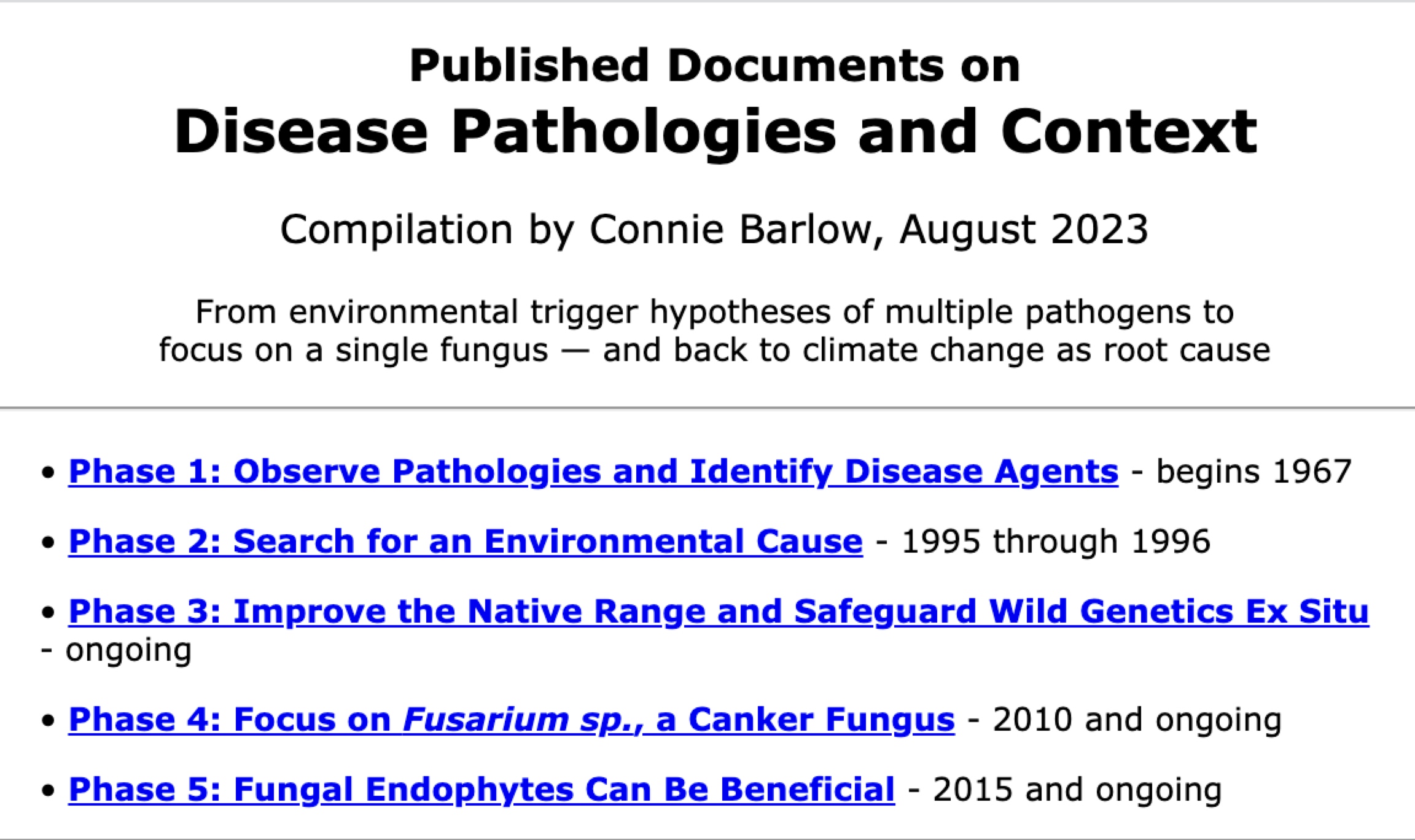 |
|
Henceforth, fungal endophytes discovered in plants are first evaluated as potential mutualists with their hosts: "Seeds contain mainly plant-beneficial microorganisms" (Abdelfattah et al. 2022)
Learn more in this new list of 48 scientific papers with excerpts (created by Connie Barlow, August 2023).
|
BARLOW REPORTS: Since 2003, I have been analyzing published papers that offer and/or test hypotheses on WHY FLORIDA TORREYA suddenly succumbed to disease(s) in its tiny native range in the 1950s, and continuing today. "Environmental stress" that provoked disease expression by weakened plants was tested in the 1990s. However, quantitative historical data (especially on temperature changes in the ravine habitat) were not adequate for the scientists to point to a specific environmental shift as the likely ultimate cause of the multiple diseases injuring the species.
In the early 2010s, new morphological standards for parsing the globally ranging FUSARIUM genus of fungi led to University of Florida researchers distinguishing and naming a NEW SPECIES from fungal isolates that previously had been called Fusarium lateritium. The new species was named Fusarium torreyae, and this gave rise to speculations that the disease was exotic and had arrived on this continent in sync with the sudden outburst of stem cankers in Florida torreya. Thenceforth, the risk of a possibly exotic pathogen spreading northward supplied new reasons for botanical garden staff to maintain hostility to "assisted migration" projects, such as those underway by Torreya Guardians.
Within the past half-dozen years, an additional risk factor put a virtual end to harvesting and distribution of tens of thousands of torreya seeds produced annually in the two ex situ orchards in n. Georgia that are "safeguarding" the wild genetics. That new risk factor derives from the finding that Fusarium torreyae was not only in "all tissues" of Florida torreya — but even in its SEEDS. This finding, however, actually offers hope for the fears to subside — but only if the botanical staff and other professionals familiarize themselves with the new (post-2014) scientific papers, such as my own compilation of 48 SCIENTIFIC PAPERS, which includes the most recent papers documenting that FUNGAL ENDOPHYTES CAN BE BENEFICIAL, especially when inside SEEDS .
• UPDATE JULY 2023:
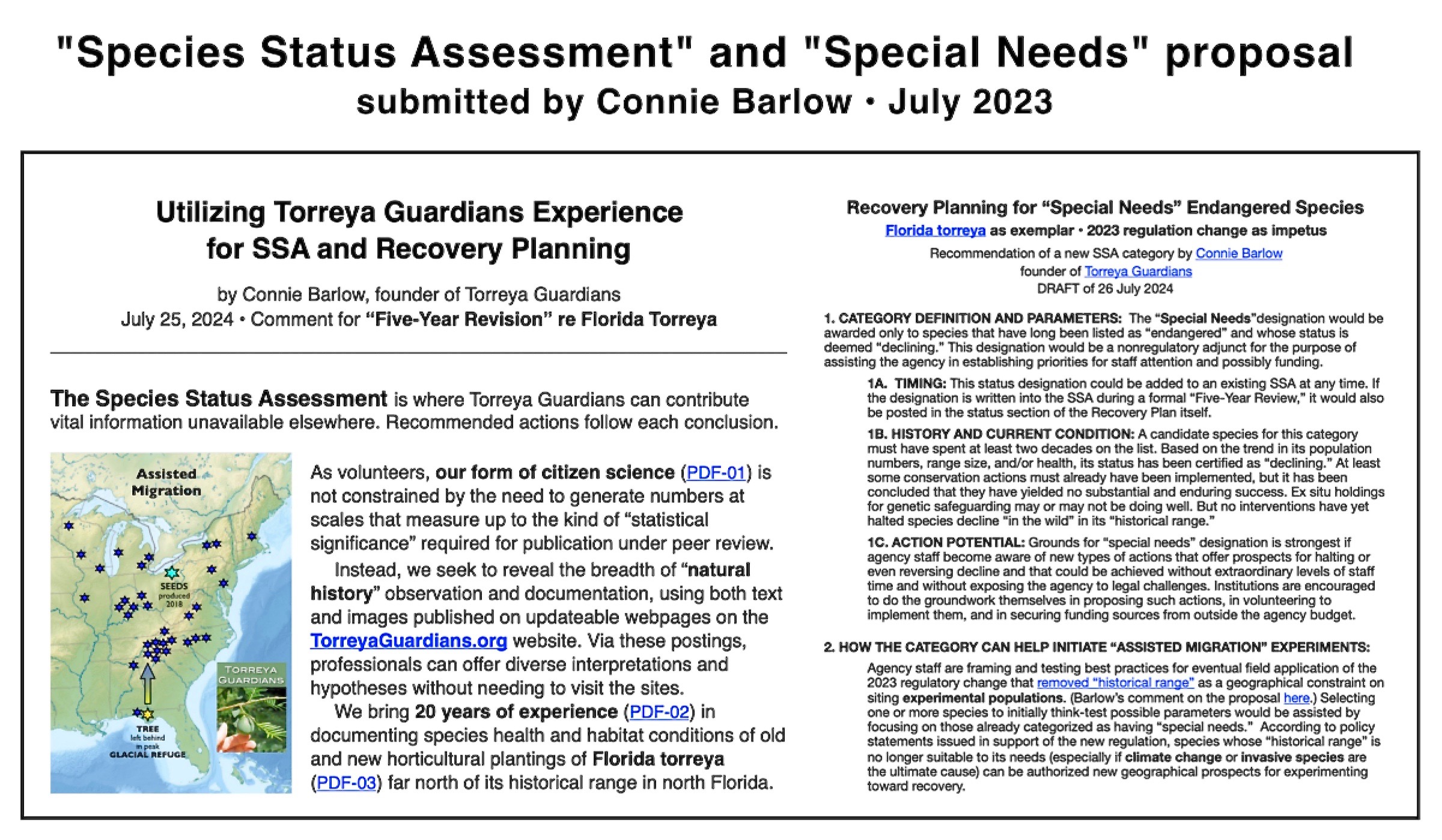
ABOVE LEFT: "Utilizing Torreya Guardians Experience for SSA and Recovery Planning - July 2023 comment by Connie Barlow to support agency staff in their required work to produce a "Species Status Assessment" in accordance with the June 2023 agency announcement that a 5-year update of the recovery plan was initiated.
ABOVE RIGHT: Recovery Planning for "Special Needs" Endangered Species - July 2023 proposal to U.S. Fish & Wildlife Service by Connie Barlow. (Also submitted as Appendix A to Barlow's official SSA comment above left.)
• UPDATE NOVEMBER 2023: New VIDEO reviews history of search for Torreya's causes of endangerment — and implications of the new papers on PLANT and SEED MICROBIOMES
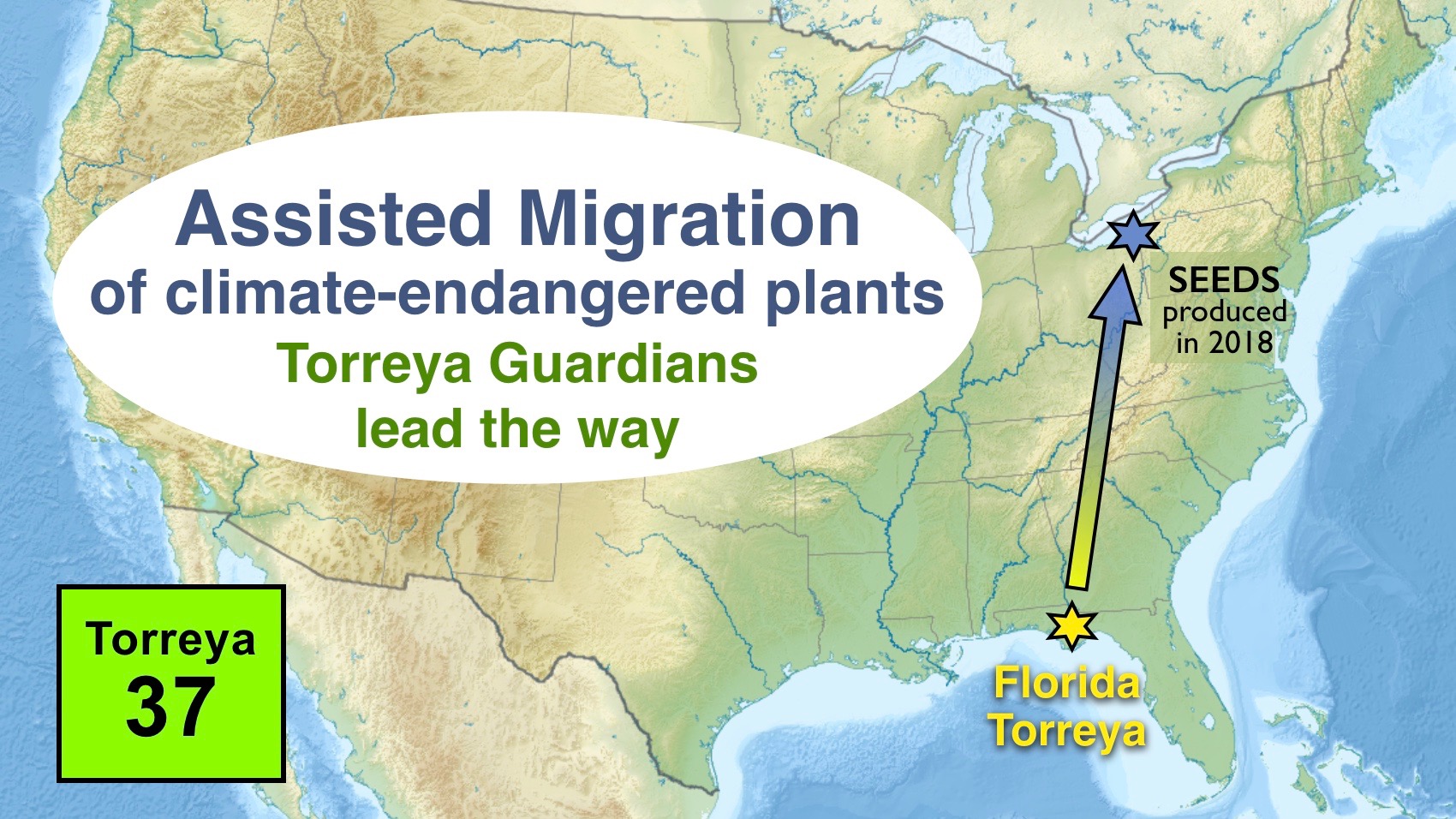 |
|
This 70-minute VIDEO begins with a celebration of the 1,000+ seeds our grower in Ohio produced autumn 2023. The rest of the video is a presentation by the group's founder, Connie Barlow, of the long and shifting history of scientific speculation and (sometimes faulty) assumptions about the ultimate cause(s) of this ancient conifer's sudden demise in its tiny historical range in Florida.
A new webpage Connie created, "Published Documents on Endangerment Causes of Torreya taxifolia in Florida", is the basis for this educational video.
|
BACKGROUND: Motivated by the July 2023 adoption of a new regulation permitting the agency in charge of the Endangered Species Act (ESA) to expand recovery efforts beyond the "historical range" — especially if climate change had already damaged prospects there — Connie began a scholarly search of new papers that might offer guidance for Florida Torreya. What she found was a "paradigm shift" (beginning around 2016) that offered new and compelling scientific reasons for the ESA implementers to follow the lead of this citizen group in "assisted migration" poleward as a way to help this tree regain its ability to fight native diseases. Central to this new understanding is the discovery that all plant tissues — including seeds — harbor beneficial fungal and bacterial partners: what is now called the PLANT MICROBIOME and the SEED MICROBIOME.
• UPDATE NOVEMBER 2024: An Opportunity Emerges for 2025
 |
|
Owing to the change in the executive branch, there is an opportunity to utilize the DOGE initiative (to reduce federal costs and increase efficiency) such that agency staff can have their time freed up to engage in real and practical actions toward fulfilling the goals of the statute.
Currently, staff are overburdened with bureaucratic and litigation demands that have ramified over the course of 51 years since the Endangered Species Act became law — and that wise POLICY shifts can ameliorate, without the need to change the law or its regulations.
|
ABOVE: 70-minute video by Connie Barlow , founder of Torreya Guardians (posted November 2024).
FURTHER READING: The "Challenges and Controversies" section of the Wikipedia page "Endangered Species Act of 1973". July of 2023, Connie began to edit this wikipedia page to improve it before the 50th anniversary of the statute in December 1973. Her work continued off and on through early January 2025. The "Challenges and Controversies" section was a new section that she contributed and wrote in its entirety. The wikipedia section is recommended because it reveals in great detail how the bureaucratic and litigation demands on agency staff have amplified exponentially over the years.
APPENDIX A: Barlow's January 2011 post, "Assisted Migration (Not Assisted Colonization) for Endangered Torreya" is reprinted here:
Below are the key points that Torreya Guardians founder Connie Barlow makes whenever discussing the topic of "assisted colonization" or "assisted migration" as a management practice to help the survival prospects of threatened and endangered plants. This blogpost is in response to the January 2011 flurry of interest in this issue, and in what she and the other Torreya Guardians have been doing for the endangered "Florida Torreya" tree since 2005. Media interest lit up when
Patrick Shirey and Gary Lambert published in the 27 January 2011 issue of the journal Nature, "Regulate Trade in Rare Plants". For full-length treatments by Connie Barlow on this issue see links at end.
* * *
A grassroots, single-species conservation group that I helped start is in the news again for moving an endangered so-called Florida species into the mountains of North Carolina. We Torreya Guardians are branded as vigilantes, but helping Florida Torreya find its way northward into the mountains of North Carolina is pretty much like deciding where to go birdwatching to see Arctic Terns in January. Every amateur birder knows that the place to find Arctic Terns when it is cold and dark in the Arctic is to take a cruise to the Antarctic waters of the Southern Hemisphere. You won't find a single "Arctic" Tern in the Arctic during the Northern Hemisphere winter. They've all gone fishing in the south polar seas.
Similarly, Florida Torreya is no more native to Florida in today's climate regime than an Arctic Tern is native to the Arctic in January.
That's why I keep using the original term for what we Torreya Guardians have been doing since 2005: assisted migration. Many professionals, and especially the critics, have started to call what
we do "assisted colonization." This is a terrible, woefully misleading description. "Assisted colonization" suggests that we are doing something artificial, something unprecedented — like we're introducing alien species, and let's just hope they don't cause problems with the natives. No wonder some professionals are so upset by what we have been doing!
But when you realize that the particular plant species we have been helping has actually been around for tens of millions of years, and that it has repeatedly had to move vast distances south and north as the continental glaciers waxed and waned, then you realize that what we Torreya Guardians are up to is assisting an ancient and lovely tree do what it has always done whenever things warm up: head north. We're just helping the tree get around habitat obstacles that we humans have put in its way. And we're helping Torreya do that a whole lot faster than its natural seed dispersers, mainly squirrels and possibly land tortoises, could otherwise do the job.
Overall, whenever Earth heats up, Florida Torreya has got to become Appalachian Torreya. Remember that in previous warm periods much of Florida has been underwater — as it soon may be again.
Over the very long term, of course, when Earth cools back down again, this beautiful conifer tree will be happy to take up residence yet again in Florida. After all, what would human "snowbirds", who are now in Florida, do in April or May if they didn't have their cars and RVs and planes to help them return to Minnesota and Michigan?
So long as the professional botanists and ecologists in charge of endangered species continue to insist that "native range" is limited to where these species were living when Europeans first arrived on this continent, they will be no better at helping our endangered species survive and thrive than Young Earth Creationists would be for explaining the geology and fossils in the Grand Canyon.
In this time of rapid climate change, we simply must acquire a deep-time perspective. We've got to look at the migratory patterns of species and habitats with eyes that honor the flow of biological history — not just human history. We've got to start thinking about "native range" in terms of thousands and millions of years, not just a few centuries.
So long as the professional botanists and ecologists in charge of endangered species lack what I like to call "deep-time eyes", they will continue to thwart the survival prospects of endangered plants. They will be more a hindrance than a help for a very silly reason: they see a bogeyman. They see the bogeyman of invasive plants, and they get scared — very scared.
To be clear: I am not discounting the threat of invasive plants. Moving a plant species from one continent to another has already plagued my homeland with Asian kudzu throughout the American deep south. Australian Melaleuca is driving out native trees in Florida. Eurasian tamarisk is sucking up precious water along the desert streams of Arizona. Eucalyptus poisons the forests around San Francisco Bay and periodically goes up in flames. To move weedy plants from one continent to another is an ecological sin. But moving a native and highly endangered conifer tree a few hundred miles northward on its home continent should be even less scary than helping the California Condor re-establish nest-holds on the Colorado Plateau — where it lived only in prehistory. (See the 2008 paper by Jillian Mueller et al, "An Assessment of Invasion Risk from Assisted Migration".)
What we Torreya Guardians are doing is helping a highly endangered and beautiful tree move quite a bit more quickly from its southern native range to its northern native range. We're just giving that hitchhiker a lift in making its way along a natural migratory path that it has been slowly traversing for hundreds of thousands — and even millions — of years.
ALSO SEE:
"The Torreya taxifolia USF&WS Recovery Plan Process: An Opportunity to Shift to a DeepTime Perspective of Native Habitat" (2010 comments submitted by Connie Barlow to the USF&WS).
"Deep Time Lags: Lessons in Pleistocene Ecology" (Connie Barlow's chapter in a 2009 MIT Press book).
"Bring Torreya taxifolia North — Now" (by Connie Barlow, with Paul S. Martin; 2005 article in Wild Earth). TECHNICAL POINT: In this paper I mention that we cannot expect to find fossil "proof" that the Appalachians are, in fact, the native habitat for this species during interglacial warm times. The Appalachian Mountains rose hundreds of milliions of years ago, and they have been eroding ever since. You don't expect to find fossil leaves there. And, unfortunately, the winddispersed pollen of genus Torreya, which can be expected to settle into bogs and ponds scattered in the Appalachian region, cannot be distinguished from three other native genera: the yews (genus Taxus), the cypress (genus Cupressus), and the bald cypress (genus Taxodium).
APPENDIX B:
Petition to Downlist from Endangered to Threatened Torreya taxifolia
26 pages in pdf, submitted by Connie Barlow, 9 September 2019
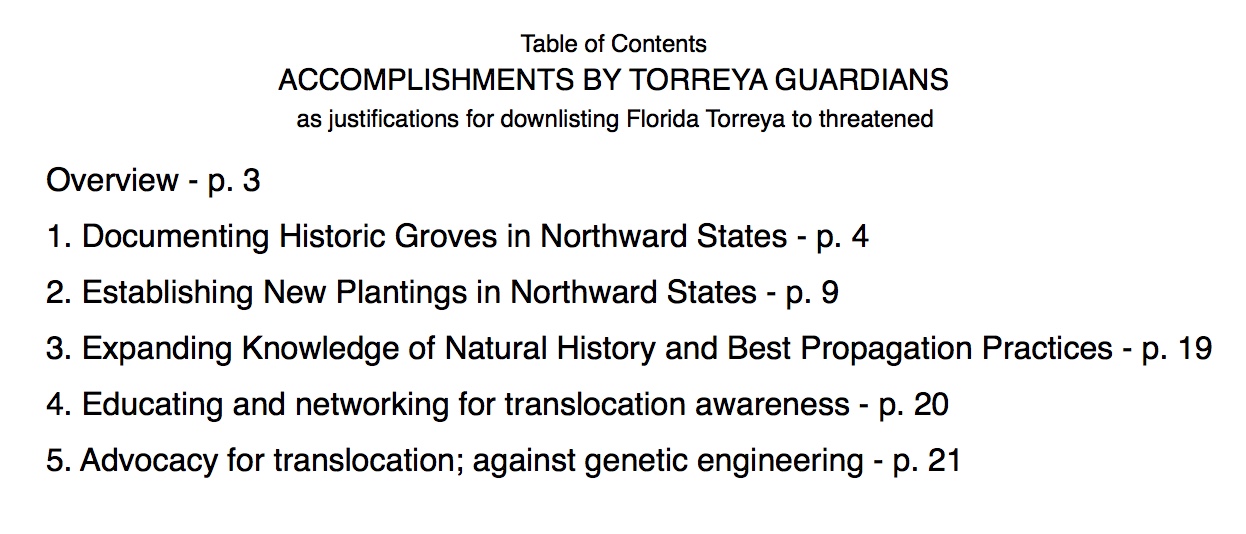
Note: Barlow mistakenly used 9 September 2018 on the title page of the petition she submitted on 9 September 2019 to USF&WS. She corrected this mistake on the version on this website.
Below are the first two pages of the 26-page pdf PETITION:
OVERVIEW OF ACTIONS BY TORREYA GUARDIANS
Since 2005, Torreya Guardians has been planting this climate-endangered "glacial relict" northward. We do so experimentally in a wide range of habitats as well as latitudes. See, for example, linked lists of our plantings in North Carolina, Tennessee, and Ohio, locales proven to be conducive not only to Torreya's growth and maturation (unimpeded by serious disease setbacks) but that also easily produce seeds in natural outdoor settings.
We also experiment with plantings as far north as Michigan and New Hampshire and have documented an historic planting of mature trees in Pennsylvania. These northern-most states are testing the limits of Torreya's cold-hardiness in today's climate, while safeguarding opportunities for the tree to flourish at those latitudes in the later decades of this rapidly warming century.
We document our results openly (failures as well as successes) via our website. These results contribute to our own learnings and our honing of best practices. By featuring photos and videos of our projects, we hope that academics, horticulturalists, and seasoned naturalists anywhere in the world will engage in offering their own interpretations and advice, without having to personally visit the sites.
We have priortized documentation of the mature groves planted in horticultural settings before the species was listed in 1984, as these plantings offer ready-made, long-term experiments for ascertaining the tree's ability to thrive — and reproduce — hundreds of miles north of where Torreya became stranded in Florida at the end of the Pleistocene glaciations. Botanists recognized Torreya as having been stranded in a glacial refugium as early as 1905.
Our efforts have been recognized in the media, in book chapters, and in academic journals. In fact, we have been so successful in our efforts to assist the migration northward of this climate-endangered "glacial relict" tree that in December 2017 an editorial in one of the top science journals stated,
"... A common prediction for how plants will respond to climate change is that it is humans who got them into this mess and so it is humans who will have to get them out of it. That's why the idea of assisted migration of species, although often illustrated with the proposal to shift polar bears to the Antarctic, crops up more frequently in conversations about how to preserve iconic trees. Indeed, in one of the only real-world examples of assisted migration so far, campaigners have planted the seeds of the critically endangered conifer Torreya taxifolia hundreds of miles north of its Florida home..." — Nature 552, 5-6 (2017)
THE PROBLEM CAUSED BY ENDANGERED LISTING
Staff with the Fish and Wildlife Service have not been an impediment to our citizen initiative. Indeed, the agency wrote into its 2010 recovery plan update: "Foster a working partnership between the Torreya Guardians, the Service, and other interested parties to help direct their managed relocation efforts." (p. 18). Five of our TorreyaGuardians.org webpages are listed as references (beginning with "http").
The endangered listing need not have been a problem. However, the two botanical gardens that control seed harvest and distribution are so adverse to our northward experimental efforts (and openly hostile to our citizen leadership) that rather than donating nonessential surplus seeds produced
ex situ in northern Georgia, the seeds have been left for local squirrels to harvest. This we know because of a Freedom of Information Act query (FOIA) that Barlow was motivated to make in 2018, following a University of Florida press release announcing intent to pursue a genetic engineering initiative to implant disease resistance into the Torreya genome.
This turn of events prompted Barlow to directly challenge the assumed need for genetic engineering. That challenge is included in the last section of this petition, "Advocacy for translocation; against genetic engineering." Following a summary and references, page 22 of this report reasons that:
1. Any possible immediate need for genetic engineering has been disqualified by a combination of (a) Prof. Jason Smith's documentation of the canker pathogen at Biltmore Gardens NC and (b) Connie Barlow's subsequent documentation of original Torreyas and their
offspring still in good health at the Biltmore.
2. The most reasonable hypothesis for northward health despite pathogen presence is that the Fusarium causes serious injury to Torreya stems only in a climate zone as warm as Florida became by mid-20th-Century.
3. The implication is that no further effort or funds should be dedicated toward attempting to manipulate the Florida habitat or manipulate the Torreya genome for the purpose of returning Florida Torreya to its peak-glacal refuge.
4. Poleward translocation (and supplementing existing Torreya groves in northward states) should thus become the core activity of all officially authorized parties.
THE VALUE OF DOWNLISTING
Downlisting would
(a) encourage citizens and organizations to recognize that that they themselves can take responsibilty for recovering endangered plants and that many private landowners would be grateful to be given an opportunity to nurture an endangered plant species. Simultaneously, it would
(b) quash the institutional trends toward cryopreservation of seed embryos in service of genetic engineering. Countering a presumptive statement (at the 2018 "Torreya Symposium") that "extinction is imminent" by the documented success of citizen volunteers in boosting recovery would
(c) draw the attention of national conservation organizations and regional land trusts. These nongovernmental organizations could then
(d) launch their own translocation experiments on citizen properties, notably those with conservation easements. Once these mainstream conservation institutions are involved
(e) Torreya Guardians could step aside. Once that happens
(f) the botanical gardens controlling seed distribution could be expected to cooperate in donating surplus seeds. Finally, with citizen plantings underway and trusted institutions handling the organization and monitoring
(g) federal taxpayer money could be freed up for recovering endangered species that aren't as easy to work with as putting seeds in a pocket and digging little holes in the forest.
Return to HOME PAGE of Torreya Guardians
Annotated List of Papers/Reports Online re Assisted Migration
• Contact: conniebarlow52 at gmail dot com
|